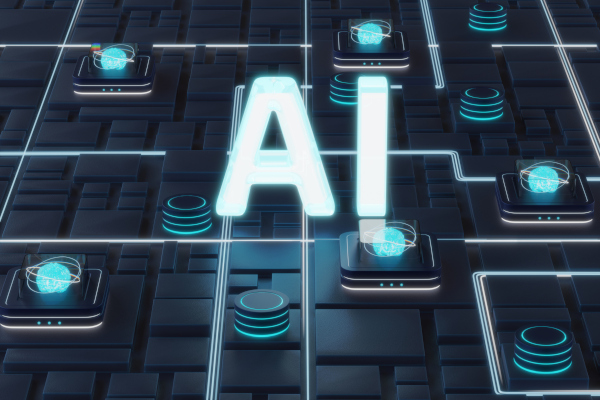Generative AI will quickly and significantly alter many aspects of supply chain — from overall strategy to the day-to-day activities of employees and their teams. Across industries, GenAI technologies have been shown to generate new derived versions of content, strategies, designs and methods by learning from large repositories of original source content.
According to Gartner Research, by 2026, more than 80% of enterprises will have used generative, artificial intelligence (AI) APIs, models and/or deployed generative, AI-enabled applications in production environments. However, with most of the GenAI discussion centering around use cases involving text and content generation, uncertainty exists among logistics leaders about how automated content generation can have any relevance to their role.
While it may not be obvious at first how GenAI can be applied to a function that primarily moves goods, our research points to opportunities to apply GenAI capabilities to logistics objectives. While encouraging, rather than jumping headfirst into piloting GenAI in your team, logistics leaders would be well-served to focus their attention today on ideation and prioritization of use cases.
The Launch Pad: Ideation and Prioritization
To begin, the first step to implementing generative AI in the supply chain is to ideate on use case ideas that align to business priorities and leverage the transformative potential of GenAI. There are five general tasks GenAI can support:
1. Written content augmentation and creation: Produce a draft output of text, which is then reviewed by the user.
2. Question answering, chatbots and information discovery: Locate answers to input, based on data and prompt information.
3. Summarization: Text manipulation can be employed to soften language or professionalize text, for example.
4. Classification of content for specific use cases: Shorten summaries of conversations, articles, emails and web pages and conversion to and from bullet points.
5. Software coding: Provide code generation, translation, explanation and verification.
Logistics leaders should evaluate these tasks against the nine functional areas for logistics: Logistics strategy, logistics performance, freight forwarding, logistics technology, outsourcing, transportation, logistics organization, warehousing and global trade management. Discuss potential use cases with your teams to determine which use cases might fit best and align with overall supply chain, logistics and business priorities.
For example, consider how GenAI can support managing logistics technology. Software programs and tools, such as transportation management systems (TMS) and warehouse management systems (WMS), have user handbooks for teams that explain how to use the program and address common issues. GenAI’s ability to support written content automation and creation can quickly draft materials based on specifications and materials provided, allowing teams to focus on other priorities. Additionally, GenAI capabilities can be applied to event logs to summarize users’ natural language, freeform text functional requirements and solution feedback to communicate or document sequencing of events or exception management in logistics flow.
Another example is leveraging GenAI to support managing logistics organization design. Tasks such as creating onboarding plans for new hires, generating organizational charts and drafting of job descriptions can be aided by GenAI. Also, addressing questions from new hires on best practices or next steps can be streamlined through question answering, chatbots and information discovery functionality.
Teams and leaders can generate and review a starting list of use cases for each function area that are relevant to their role as a logistics leader and within a logistics team. From there, the next step to implementing generative AI in the supply chain is to prioritize which use cases the team will actually pursue. We recommend prioritizing no more than a few GenAI use cases, building a small portfolio that balances value and feasibility.
The Opportunity for GenAI in Logistics
As logistics leaders begin considering where GenAI use cases might apply or improve their business, it’s also important to keep in mind that they need to assess the organization’s level of maturity, internal capability and data and talent availability.
Highly mature organizations might have the technology, data and the talent to develop and customize solutions. Lower maturity organizations, on the other hand, may lack one or more of these requirements and should consider embedded offerings of technology or service providers they work with.
It’s also important to consider quick wins. As this is a new and quickly evolving space, taking advantage of embedded options in solutions or technology already used by the organization will drive quicker wins. The same can be said for obvious use cases that would apply to most logistics functions.
Lastly, it’s critical to not overlook the human component of supply chain and logistics operations. While GenAI functionality offers promise for increasing productivity and efficiency, human domain knowledge must be considered and incorporated into the strategy to achieve value.
About the authors:
Carly West and Jose Reyes are senior research directors in the Logistics and Customer Fulfillment team of the Gartner Supply Chain Practice.
SC
MR


Latest Supply Chain News
Latest Resources

 Explore
Explore
Software & Technology News
- Nine questions are the key to AI success in building resilient supply chains
- Looking back at NextGen 2024
- AI is moving omnichannel closer to the customer
- How technological innovation is paving the way for a carbon-free future in logistics and supply chains
- Körber Supply Chain Software’s Craig Moore says MercuryGate acquisition is about the customer
- Robotic use grows by 10%
- More Software & Technology
Latest Software & Technology Resources

Subscribe

Supply Chain Management Review delivers the best industry content.

Editors’ Picks




